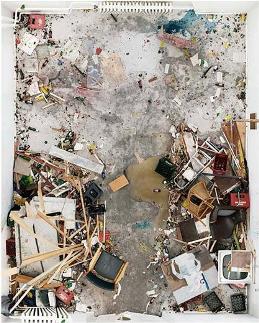[In our latest look at fine arts photographers who might have something to offer photojournalists, contributing editor Stephanie Mitchell considers the Supervisions project of Andreas Gefeller. Gefeller’s collapsed images and simultaneous use of exterior and interior shots offer exciting possibilities for storytelling, particularly in relation to architecture and urban topography. –Ed.]

“Untitled (Academy of Arts),” Düsseldorf, 2009/Andreas Gefeller
Ice tracks ramble across a blackened field. Concrete slabs from a Holocaust memorial generate a precise grid pattern. Remnants of a building foundation leave a faint impression. These images lay the groundwork for an inventive collection of contemporary photographs.
Supervisions, the latest volume by German photographer Andreas Gefeller, surveys landscapes and interior spaces with the acute detail seen in images by fellow contemporary German photographer Andreas Gursky. Gefeller, however, upends his tripod, positioning his camera in perfect perpendicular position to his subjects. With enviable results, Gefeller carries on the tradition of bird’s-eye-view imagery launched by the French photographer Felix Nadar over one hundred years ago.
The substantial photographs—the largest is more than 12 feet long—read as maps, architectural drawings, and archaeological records that document communal spaces. Gefeller captures beaches, forests, parking lots, offices and cemeteries in exacting details, hues and textures. Serialized grids, patterns and repetitions expose both the sameness and variety of the sites.
While the photographs portray unpopulated landscapes, evidence of human activity and human life are plentiful. Beach sands are crowded with footprints, ocean waters are rippling with activity, painted street markings are weathered to faint impressions, urban streets are scarred with graffiti declarations, and tombstones mark the graves of buried ancestors. Viewers imagine the characters that passed through and the activities that transpired.
With flawlessly flat light, the images seem to document the spaces that they depict, yet they record an unreality, an impossible space. Gefeller aims a camera adhered to a boom at the ground and photographs the locations section by section. Therefore, each image is in fact a composite of hundreds of images stitched together by digital means. A space, potentially teeming with people, is imagined as a vacant landscape. Photography, considered the art of recording a solitary split second, is re-visioned by Gefeller, whose painstakingly complex composite images are constructed over long durations of time. In this way, Gefeller considers questions of truth and illusion and the role photography plays in this long-standing debate.
Gefeller’s aerial composites also reverse the relationship between film and photography. Whereas film compiles multiple images—24 per second—to simulate motion, Gefeller reduces multitudes of images—sometimes more than 1,000—to a single image. Gefeller takes motion, activity and chaos, and collapses them to stillness.
His method causes illusory effects that can both add and subtract key elements. A swimming pool, vacant of swimmers, is swirling with activity. Bright yellow leaves encircle an unseen tree. Rows of trees cast elongated shadows, but the actual trees and their branches, the source of the shadows, are absent. And due to the extensive image capture time, the trees’ shadows lengthen and shift reflecting the changing movement of the sun. The interior and exterior spaces of a church and the surrounding cemetery are captured in a single image, as if the roof has been stripped from the building.

“Untitled (Academy of Arts R 209),” Düsseldorf, 2009/Andreas Gefeller
The collection’s title has an inherent double meaning. Supervisions suggest the watchful eye of surveillance, the all-knowing perspective from above, as well as “super visions”—enhanced vision, beyond vision, or better than vision. In this way, Gefeller asserts the discovery of a new way of seeing, an original perspective.
The collection includes sites from the Netherlands, Finland, New York and Hong Kong, but the most fully realized achievements are from Gefeller’s birthplace of Dusseldorf, Germany, and specifically at the Dusseldorf Academy of Arts.
The series begins with an architectural floor plan view of an entire level of the renowned art academy, which boasts internationally known professors and graduates, including Andreas Gursky, Gunter Grass, Paul Klee and Gerhard Richter. Lecture halls, studio and critique spaces, and seminar and storage rooms are bound together by hallways crowded with abandoned canvases. The immense photograph, an exacting collage of more than 1,000 images, is followed by a room-by-room study of individual spaces.
The hyper-realistic detail recalls the precision of an excavation. Trace outlines of canvases are scattered with cigarette butts, pens, and bottles. In an active studio space, the floor, with splotches of sprayed and dripped paint, is an unintended Jackson Pollock canvas. The interiors mark the territory of artistic inspiration and innovation.
Writer Gerhard Gluher aptly identifies the distinctiveness of Gefeller’s work when he states, “Absolutely nothing happens in Gefeller’s pictures, according to the classical criteria of narratology, yet they defy inclusion in the traditional canon of photographic documentation.” As time and duration interplay with his meticulous imaging of reality, Gefeller creates a new mode of representation. Thus, residing in a place between fact and fantasy, Gefeller simultaneously documents and invents the worlds around him.
[To see how Gefeller collects his images, watch this Euromaxx video clip.]

